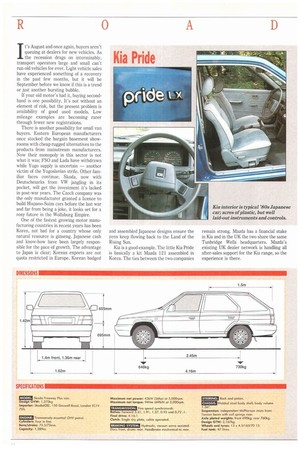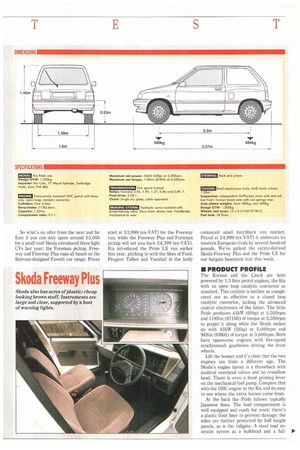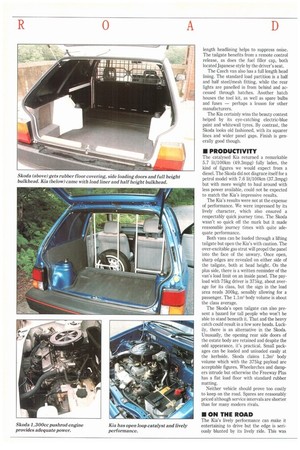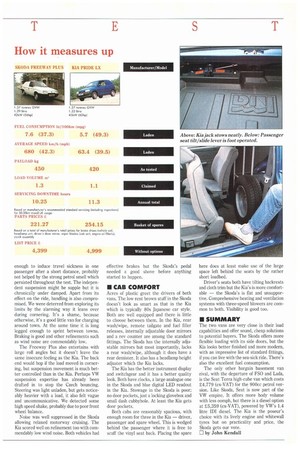I t's August and once again, buyers aren't queuing at dealers
Page 34

Page 35

Page 36

Page 37

If you've noticed an error in this article please click here to report it so we can fix it.
for new vehicles. As the recession drags on interminably, transport operators large and small can't run old vehicles for ever. Light vehicle sales have experienced something of a recovery in the past few months, but it will be September before we know if this is a trend or just another bursting bubble.
If your old motor's had it, buying secondhand is one possibility. It's not without an element of risk, but the present problem is availability of good used models. Low mileage examples are becoming rarer through fewer new registrations.
There is another possibility for small van buyers. Eastern European manufacturers once stocked the bargain basement showrooms with cheap rugged alternatives to the products from mainstream manufacturers. Now their monopoly in this sector is not what it was; FS0 and Lada have withdrawn while Yugo supply is uncertain — another victim of the Yugoslavian strife. Other familiar faces continue. Skoda, now with Deutschmarks from VW jangling in its pocket, will get the investment it's lacked in post-war years. The Czech company was the only manufacturer granted a licence to build Hispano-Suiza cars before the last war and far from being a joke, it looks set for a rosy future in the Wolfsburg Empire.
One of the fastest growing motor manufacturing countries in recent years has been Korea, not bad for a country whose only natural resource is ginseng. Japanese cash and know-how have been largely responsible for the pace of growth. The advantage to Japan is clear; Korean exports are not quota restricted in Europe. Korean badged and assembled Japanese designs ensure the yens keep flowing back to the Land of the Rising Sun.
Kia is a good example. The little Kia Pride is basically a kit Mazda 121 assembled in Korea. The ties between the two companies remain strong. Mazda has a financial stake in Kia and in the UK the two share the same Tunbridge Wells headquarters. Mazda's existing UK dealer network is handling all after-sales support for the Kia range, so the experience is there. So what's on offer from the near and far East if you can only spare around £5,000 for a small van? Skoda introduced three light CVs last year; the Foreman pickup, Freeway and Freeway Plus vans all based on the Bertone-designed Favorit car range. Prices start at £3,999 (ex-VAT) for the Freeway van, while the Freeway Plus and Foreman pickup will set you back £4,399 (ex-VAT). Kia introduced the Pride LX van earlier this year, pitching in with the likes of Ford, Peugeot Talbot and Vauxhall in the hotly contested small hatchback van market. Priced at £4,999 (ex-VAT) it undercuts its western European rivals by several hundred pounds. We've picked the estate-derived Skoda-Freeway Plus and the Pride LX for our bargain basement test this week.
• PRODUCT PROFILE The Korean and the Czech are both powered by 1.3 litre petrol engines, the Kia with an open loop catalytic convertor as standard. This catalyst is neither as complicated nor as effective as a closed loop catalytic convertor, lacking the advanced control electronics of the latter. The little Pride produCes 45kW (60hp) at 5,500rpm and 118Nm (871bft) of torque at 3,500rpm to propel it along while the Skoda makes do with 42kW (56hp) at 5,000rpm and 94Nm (691bft) of torque at 3,000rprn. Both have transverse engines with five-speed synchromesh gearboxes driving the front wheels.
Lift the bonnet and it's clear that the two engines are from a different age. The Skoda's engine layout is a throwback with pushrod overhead valves and no crossflow head. There is even a hand priming lever on the mechanical fuel pump. Compare that with the OHC engine in the Kia and its easy to see where the extra horses come from.
At the back the Pride follows typically Japanese lines. The load compartment is well equipped and ready for work: there's a plastic floor liner to prevent damage; the sides are further protected by half height panels, as is the tailgate. A steel load restraint serves as a bulkhead and a fullPI*
length headlining helps to suppress noise. The tailgate benefits from a remote control release, as does the fuel filler cap, both located Japanese style by the driver's seat.
The Czech van also has a full length head lining. The standard load partition is a half and half steel/mesh fitting, while the rear lights are panelled in from behind and accessed through hatches. Another hatch houses the tool kit, as well as spare bulbs and fuses — perhaps a lesson for other manufacturers.
The Kia certainly wins the beauty contest helped by its eye-catching electric-blue paint and whitewall tyres. By contrast, the Skoda looks old fashioned, with its squarer lines and wider panel gaps. Finish is generally good though.
• PRODUCTIVITY
The catalysed Kia returned a remarkable 5.7 lit/100km (49.3mpg) fully laden, the kind of figures we would expect from a diesel. The Skoda did not disgrace itself for a petrol model with 7.6 lit/100km (37.3mpg) but with more weight to haul around with less power available, could not be expected to match the Kia's impressive results.
The Kia's results were not at the expense of performance. We were impressed by its lively character, which also ensured a respectably quick journey time. The Skoda wasn't so quick off the mark but it made reasonable journey times with quite adequate performance.
Both vans can be loaded through a lifting tailgate but open the Kia's with caution. The over-excitable gas strut will propel the panel into the face of the unwary. Once open, sharp edges are revealed on either side of the tailgate, both at head height. On the plus side, there is a written reminder of the van's load limit on an inside panel. The payload with 75kg driver is 375kg, about average for its class, but the sign in the load area reads 300kg, sensibly allowing for a passenger. The 1.1ma body volume is about the class average.
The Skoda's open tailgate can also present a hazard for tall people who won't be able to stand beneath it. That and the heavy catch could result in a few sore heads. Luckily, there is an alternative in the Skoda. Unusually, the opening rear side doors of the estate body are retained and despite the odd appearance, it's practical. Small packages can be loaded and unloaded easily at the kerbside. Skoda claims 1.3m' body volume which with the 375kg payload are acceptable figures. Wheelarches and dampers intrude but otherwise the Freeway Plus has a flat load floor with standard rubber matting.
Neither vehicle should prove too costly to keep on the road. Spares are reasonably priced although service intervals are shorter than for many modern rivals.
• ON THE ROAD
The Kia's lively performance can make it entertaining to drive but the edge is seriously blunted by its lively ride. This was enough to induce travel sickness in one passenger after a short distance, probably not helped by the strong petrol smell which persisted throughout the test. The independent suspension might be supple but it is chronically under damped. Apart from its effect on the ride, handling is also compromised. We were deterred from exploring its limits by the alarming way it leans over during cornering. It's a shame, because otherwise, it's a good little van for charging around town. At the same time it is long legged enough to sprint between towns. Braking is good and other refinements such as wind noise are commendably low.
The Freeway Plus also entertains with large roll angles but it doesn't leave the same insecure feeling as the Kia. The back end would hop if the load moved in cornering, but suspension movement is much better controlled than in the Kia. Perhaps VW suspension expertise has already been drafted in to stop the Czech bouncing. Steering was light unladen, but gets noticeably heavier with a load, it also felt vague and uncommunicative. We detected some high speed shake, probably due to poor front wheel balance.
Noise was well suppressed in the Skoda allowing relaxed motorway cruising. The Kia scored well on refinement too with commendably low wind noise. Both vehicles had effective brakes but the Skoda's pedal needed a good shove before anything started to happen.
• CAB COMFORT
Acres of plastic greet the drivers of both vans. The low rent brown stuff in the Skoda doesn't look as smart as that in the Kia which is typically 80s Japanese car style. Both are well equipped and there is little to choose between them. In the Kia, rear wash/wipe, remote tailgate and fuel filler releases, internally adjustable door mirrors and a rev counter are among the standard fittings. The Skoda has the internally adjustable mirrors but most importantly, lacks a rear wash/wipe, although it does have a rear demister. It also has a headlamp height adjuster which the Kia lacks.
The Kia has the better instrument display and switchgear and it has a better quality look. Both have clocks, a large analogue one in the Skoda and blue digital LED readout in the Kia. Stowage in the Skoda is poor; no door pockets, just a locking glovebox and small dash cubbyhole. At least the Kia gets door pockets.
Both cabs are reasonably spacious, with enough room for three in the Kia — driver, passenger and spare wheel. This is wedged behind the passenger where it is free to scuff the vinyl seat back. Placing the spare here does at least make use of the large space left behind the seats by the rather short loadbed.
Driver's seats both have tilting backrests and cloth trim but the Kia's is more comfortable — the Skoda's is flat and unsupportive. Comprehensive heating and ventilation systems with three-speed blowers are common to both. Visibility is good too.
• SUMMARY
The two vans are very close in their load capabilities and offer sound, cheap solutions to potential buyers. The Skoda offers more flexible loading with its side doors, but the Kia looks better finished and more modern, with an impressive list of standard fittings, if you can live with the sea-sick ride. There's also the excellent fuel consumption.
The only other bargain basement van rival, with the departure of FS0 and Lada, is the Seat Terra high-cube van which costs £4,779 (ex-VAT) for the 900cc petrol version. Like Skoda, Seat is now part of the VW empire. It offers more body volume with less oomph, but there is a diesel option at £5,359 (ex-VAT), powered by VW's 1.4 litre IDI diesel. The Kia is the poseur's choice with its lively engine and whitewall tyres but on practicality and price, the Skoda gets our vote.
0 by John Kendall












































































